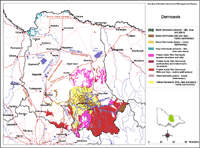Dermosols
Dermosols are non texture contrast soils that have structured subsoils (B horizons). They are found mainly in the upland areas, often in association with Kandosols which have massive B horizons. These soils can vary from stony hardsetting soils to friable deeper profiles. Some may almost have some texture contrast and a bleached subsurface (A2) horizon. Using the Australian Soil Classification, Dermosols can be grouped further (into Suborders) based on the colour of the upper 20 cm of the subsoil (i.e. Red, Brown, Yellow, Grey and Black). These can be further differentiated (into Great Groups) based on subsoil characteristics such as the nutrient level capacities and ratios and the presence of carbonate or lime.
The major occurrences of Dermosols are on the uplands. There are some on the Strathbogie Ranges, but they are mainly found in the moister areas closer to the Dividing Range as well as the Alexandra/Eildon area.
| Dermosols in the Goulburn Broken Region This broad scale map presents an overview and should only be used as a general indication of the distribution of Dermosols in the Goulburn Broken Region. It shows areas where Dermosols are most likely to occur within the region. Note that other soil types may also occur within these mapped areas (although they are likely to be a more minor component). This map has been developed from work done by DPI's former Centre for Land Protection Research as part of the Goulburn Broken Dryland Regional Development Project. This work utilised existing surveys, remote sensing information and some additional field work to develop an updated 1:100 000 soil/landform coverage across the region. |  Dermosols in the Goulburn Broken Region |
| Soils are difficult to map at this broad scale because of their diversity. Even in relatively small areas, a number of soils may occur which relate to differences in topography and landscape position. Variation in some of the major soil profile properties can also occur within these mapped areas. Any agricultural enterprise should be based on a proper on-site assessment of the soil and landscape. A number of soil surveys have been completed in this region at varying scales and intensity. However, in some areas very little soil survey has taken place (see the Soil and Land Survey Directory). | |
Red Dermosols
Red Dermosols are located closer to the Divide in the wetter climatic areas. These soils are moderately to strongly structured, usually with high organic matter levels in the surface horizons and have strongly acid subsoils (B horizons). They are also usually friable when moist.
There are often brown variants of this soil type in association with the red subsoils. These soils are characteristically friable unlike other Dermosols in lower rainfall areas. The field texture test can often underestimate clay content in these soils (i.e. they have a higher clay content than the hand texture would suggest) due to their clay composition. Red Ferrosols and Kandosols are similar in this way. In some cases, such as the Blue Range south of Mansfield, the colour of the subsoil has more to do with the colour of the parent material than the usual pedological processes.
Brown, Yellow and Grey Dermosols
Brown, Yellow and Grey Dermosols are generally located in the drier areas. However, they can vary from being less well developed (almost Rudosols) which are shallow and stony, to strongly developed - almost texture contrast with hardsetting, bleached subsurface horizons with ironstone gravel (concretions/nodules) and often mottled subsoils. The more developed profiles are typical of the sedimentary terrain around Alexandra and to some extent Yea. This highly dissected country often exhibits sequences (catenas) from the crests to the drainage lines, with shallower often less developed soils on the crests and deeper soils on the lower slopes. Many of these soils are sodic at depth and there are salinity problems in some areas. This contrasts with the structured and friable soils of the Goulburn River alluvial plain (flats).
There are also some occurrence of Dermosols on remnant rises and low hills north east of Euroa and on alluvial material on the Murray River plain.

